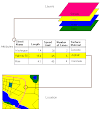One book that started me thinking was "The Silent Knife" by Nancy Cohen and Lois Estner. Women were hustled into surgery for stupid reasons, often with poor results. I don't recommend that pregnant women read this; the scenarios of the book were more common in the 1970s. This was first published in 1983. I listened to many friends' birth stories in the 1980s, and many of them had to tolerate obtrusive and ineffective interventions during their labors. There had to be a better way. The books listed below show what that way is.
Ina May Gaskin writes some of the most readable books around. I read "Spiritual Midwifery" while pregnant - it was in the library of my birth center. This book has many birth stories, and also a technical section on birthing. The birth stories date back to the 1970s, and also include more recent births by the second generation at The Farm. The birth stories run the gamut of experience, which was very educational for me. The mainstream "just listen to your doctor" birth books do not describe the variety of experiences that labor can be.
Her newest book, "Ina May's Guide to Childbirth" has a combination of birth stories, history of childbirth care, and Ina May's theories of the needs of laboring women. If there's only one birth book you read, this should be it. I found everything in it to be true in my experience.
My other favorite, tied with "Ina May's Guide to Childbirth" is "Natural Childbirth the Bradley Way" by Susan McCutcheon-Rosegg. I bought this book when my sister was pregnant in 1987, and her childbirth prep classes turned out to be nothing more than cesarean prep classes. There were no Bradley classes at the time in her town. She used it as a manual, and took it to the hospital with her to serve as a guide for her husband. She wrote in hers, and gave it back to me when I was pregnant. I added my notes, and have passed it around till the binding wore out. Now it's a family heirloom, held together with string. I have purchased new copies and added our annotations for other new mothers I've known. The pictures in the book were very useful visualizations for me during the hardest part of labor. Also, it was the first time I had seen pictures of birth in positions other than flat on back, legs in air. Dr. Bradley also wrote his own book. I read it about 20 years ago, found the tone a little patronizing so I like Susan McCutcheon's book better.
If you have doubts of your ability to give birth,
An Easier Childbirth: A Mother's Guide for Birthing Normally by Gayle Peterson was one of the required reading books at the birth center we used. It is a workbook that asks many questions for the pregnant woman to think about and answer. It brings hidden fears and conflicts to the surface where they can be resolved. Its aim is to address emotional issues ahead of time so they do not surface in labor and hinder the birth. It's excellent.
*Update June 21, 2009*
I just read another book - by Mayer Eisenstein, M.D., "The Home Birth Advantage: A Time-Honored Tradition for the New Millennium." It is fantastic. In very easily read terms, it explains exactly what I think about the hospital and surgically centered birthways found in the United States. Even if you are NOT considering home birth, you should read it.
*Update June 23, 2009*
Just finished "Your Best Birth" by Ricki Lake and Abby Epstein. This is the same team that made the documentary "The Business of Being Born." It is excellent as an overview of what to expect from different kinds of birth services in the U.S.
*Update June 29, 2009*
Another one just finished: "Gentle Birth Choices" by Barbara Harper. After doing a Google search on that title, also found reference to a video by the same author. Bet that would be good. This book describes the history of birth practices in this country, talks about international birth safety statistics, and describes the typical experiences of the home, birth center, and hospital birth. It has a lot of information on water birth. I highly recommend it.
Subscribe to:
Post Comments (Atom)

No comments:
Post a Comment